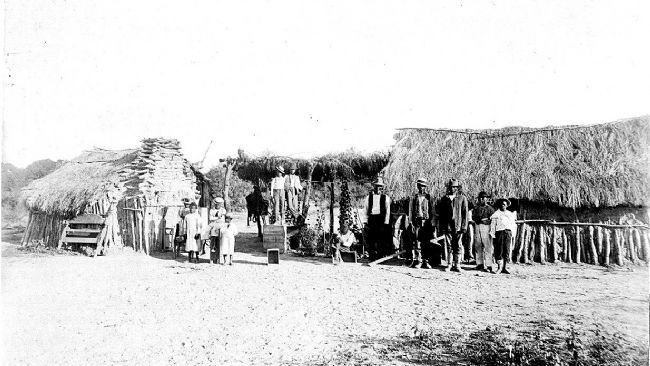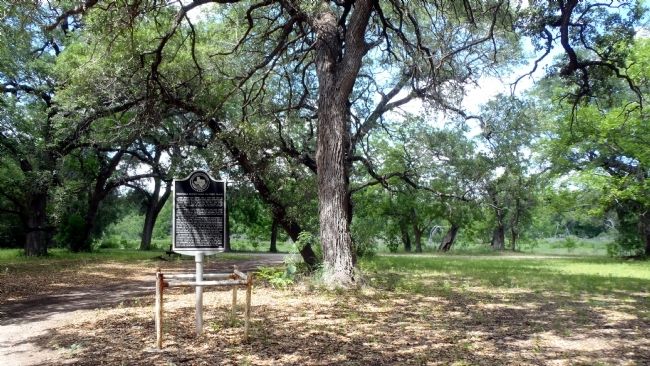Near Brackettville in Kinney County, Texas — The American South (West South Central)
Seminole Scout Camp on Fort Clark
Tribal leaders Coacooche (Wild Cat) and John Horse gathered a group of Seminoles in 1850 and left the Indian Territory for Mexico. There, under an agreement with the Mexican government, they settled and fought against raiding tribes along the Rio Grande.
In 1870, the U.S. Army offered the group pay and rations to move to Fort Clark, established in 1852 to protect settlers along the border. The black Seminoles became scouts for the army, serving under such famous officers as Lt. John L. Bullis, during Texas’ Indian Wars. The Seminole-Negro Indian Scouts, as they were known, lived on the fort in a settlement referred to as “the camp.” They built homes in the Mexican jacal style, using wattle and daub construction and thatched roofs. The scouts and their families also built dams and irrigation systems along Las Moras creek for farming.
The Seminoles lived on the fort until 1914, when the scouts were disbanded. Some returned to Mexico, many stayed in the Brackettville area and some moved to Oklahoma, where the Seminole Nation was granted sovereignty. Still others remained, buried in the scout’s cemetery (1.5 mi. SW), which was established in 1872. Among those buried there are four scouts who earned Congressional Medals of Honor: Adam Payne (Paine), Isaac Payne, John Ward and Pompey Factor. (2002)
Erected 2002 by Texas Historical Commission. (Marker Number 12933.)
Topics. This historical marker is listed in these topic lists: African Americans • Wars, US Indian. A significant historical year for this entry is 1821.
Location. 29° 16.824′ N, 100° 25.294′ W. Marker is near Brackettville, Texas, in Kinney County. Marker is on Pecan Road, on the right when traveling north. Marker is located on Fort clark Springs and is accessible to the public. The marker site is in a wilderness area and requires GPS navigation skills to locate, but it will be worth the effort. Touch for map. Marker is in this post office area: Brackettville TX 78832, United States of America. Touch for directions.
Other nearby markers. At least 8 other markers are within 2 miles of this marker, measured as the crow flies. Forsyth Bridge (approx. 0.7 miles away); John Horse (approx. 1.4 miles away); Seminole Indian Scouts' Cemetery (approx. 1.4 miles away); Site of Original Post Cemetery (approx. 1.4 miles away); Commanding Officer's Quarters
(approx. 1.6 miles away); 1873 Infantry Barracks (approx. 1.7 miles away); Staff Officers' Quarters (approx. 1.7 miles away); Palisado Building Kitchen / Mess Room (approx. 1.7 miles away). Touch for a list and map of all markers in Brackettville.
More about this marker. The marker is located in a picnic grove of ancient Spanish oak and pecan trees adjacent to a pond. Las Moras Creek flows near the site. Pecan Road traverses the length of the Seminole Camp and the marker is actually located at the site of the post vegetable gardens.
Additional commentary.
1. Seminole Scout Camp on Fort Clark
Subject markers commemorate topics significant in Texas history; the “Seminole Scout Camp on Fort Clark” marker commemorates a particularly significant subject … a community … a community of unique people, people who are the stuff of legend! To be legendary you must have something handed down from an ancestor, a tradition of accomplishments and individuals whose fame promises to be enduring. The Seminole people embody just such a legacy.
In August of 1872 the John Daniels band

Courtesy Old Guardhouse Museum, circa 1896
3. Historic view of the Seminole Scout Camp on Fort Clark
A Seminole settlement was established on Fort Clark in 1872. The Scouts and their families lived along the course of Las Moras creek some two miles south of the main post garrison. They referred to their simple jackel thatched roofed homes as “the camp.” Of his first visit there in May 1883, Lieutenant Francis H. French, of the 19th Infantry, who was then commanding the scouts wrote, “Rode all around camp with Sgt. Kibbets and saw where the animals graze and where the men live. Some of them keep their places in nice condition all the time while others live like pigs.” These men and children are unidentified, possibly scouts on leave from Fort Duncan.
Bullis and the Scouts were the vanguard for Mackenzie’s Remilino Raid in 1873 and participated in subsequent raids into Mexico with “Pecos Bill” Shafter and S.B.M. Young. The exploits of the Seminole Scouts and their heroic commander in the Lower Pecos and Big Bend region are illustrious. Three Scouts received the Congressional Medal of Honor for rescuing Bullis during a battle with Comanches at the mouth of the Pecos on April 25th, 1875. It was Bullis and his Scouts who first established a road into and out of the Pecos canyon, making a wagon crossing practical and opening the country west of the Pecos. Bullis relinquished command of the Scouts in July of 1881.
Two incidents in time came to tarnish the otherwise peaceful existence of the Seminoles in their camp. On May 19, 1876 former scout Titus Payne and John Horse were attacked by townspeople in a night ambush near the Original Post Cemetery while returning to the camp. Payne was killed, but John Horse, the Seminole patriarch, survived his four wounds. Afterwards many Seminole families returned to Mexico in fear of further troubles. By year’s end the close-knit community was in turmoil. The arrival of wanted fugitives Adam Paine, former scout and Medal of Honor recipient, and a border-area bandit, Frank Enoch, only added to the unrest. On New Year’s Eve the Kinney County Sheriff and his deputy, Medal of Honor recipient Claron A. Windus, learned the wanted men were in the Seminole Camp. In a clearing where the Seminoles were welcoming in the new year of 1877 shots rang out and Adam Paine fell dead, shot in the back by Windus at such close range Paine’s clothes burst into flames. This is the only known instance where one Medal of Honor man killed another.
For forty-four years the Scout Detachment proved a very cost-effective organization for the army as the Seminoles were always producing more scouts! Oral tradition recounts that when a male child was born in the Seminole camp during the time Bullis was in command of the Scouts the child was presented to the lieutenant for him to determine if the boy would ever be a scout. The Scouts usefulness had always been their unequalled tracking skills, stamina on campaign, and fearlessness in combat. With the end of the Indian Wars in the early 1890’s the mission of the Scouts shifted to border security. Although the detachment continued to serve into the new century it was no longer of any practical use to the Army. Having served 37 years at Fort Clark, longer than any other unit, the Scout Detachment was disbanded on September 30, 1914. The remaining eight scouts were “discharged from the Service of the United States” and ordered to move from the Fort Clark Military Reservation with all their stock and belongings; however, twenty-four named members of the “Scout Camp” were, “… permitted to remain and live on the … Reservation until the older people pass away in the course of nature, or until such time as the War Department may see fit to order their removal.” As they had always done the Seminole people persevered, moving to Brackettville where retired Scouts had already established a presence. The last Scout, Curly Jefferson, died in 1959.
— Submitted May 20, 2012, by William F Haenn of Fort Clark (Brackettville), Texas.
Credits. This page was last revised on August 27, 2020. It was originally submitted on May 13, 2012, by William F Haenn of Fort Clark (Brackettville), Texas. This page has been viewed 1,001 times since then and 37 times this year. Photos: 1, 2, 3. submitted on May 13, 2012, by William F Haenn of Fort Clark (Brackettville), Texas. • Craig Swain was the editor who published this page.

